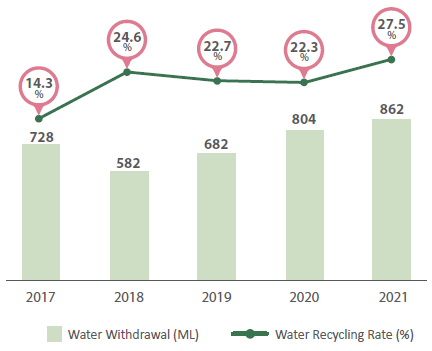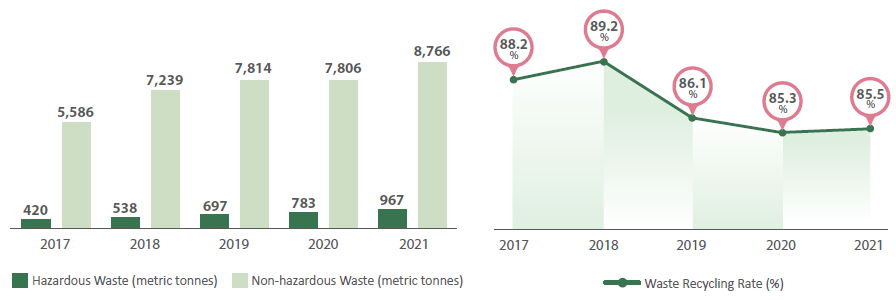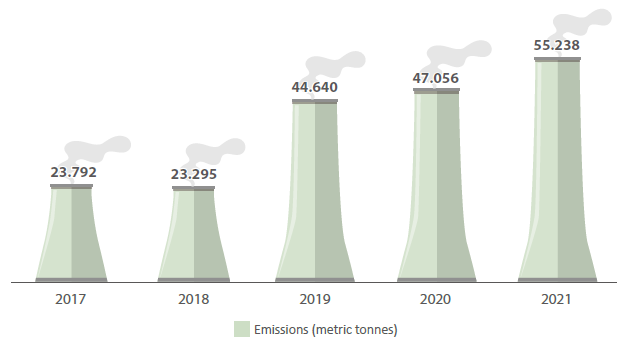
Environmental Protection & Occupational Safety
Pollution Control
USI considers "Waste Minimization and Reuse" as corporate policy. The principles of "Effective Reduction & Circular Reuse" and "Impact Mitigation & Continuous Improvement" have been carried out thoroughly in all the facilities and treated as annual performance indicator.
USI has been making efforts in conserving water resources and continues to manage the resources in our production and daily life. Apart from regularly tracking the water usage of USI's six major manufacturing facilities, USI also commissions a third-party to check the quality of effluents on a regularly basis to prevent water pollution from happening. There was no violation of water discharging regulations in 2021, and USI will continue to keep a track on the use of precious water resource and save as much water as possible for a friendly environment and reduction of environmental impacts.USI total water consumption in 2021 was 861.89 ML, an increase of 7.2% from 2020 (803.69 ML). However, our water intensity is reduced by 36.4% compared with 2015, achieving the goal of water saving. In addition,the process water consumption is 314.13 ML, with a recycling rate of 73.1%.

USI has developed a waste disposal program specifying that hazardous wastes must be handled by qualified suppliers with valid licenses for disposal and that non-hazardous wastes must be given to licensed recycling operators for recycling or shipped to the licensed incinerators for incineration. During the waste removal process, the responsible EHS department monitors and follows vehicles from time to time and review the track records of the waste removal vehicles to confirm that the waste is handled in accordance with the regulations and contracts.According to the statistics, the total amount of waste generated in 2021 was 9,733.33 metric tonnes, and the recovery amount was 8,318.25 metric tonnes, with a recovery rate of 85.5%. Although it is slightly higher than the previous year, it still meets the annual target (80%).

In recent years, air pollution is getting worse in Mainland China and Taiwan. It seriously affected the quality of life to residents that become an urgent issue. This is the reason that local authority has made relevant amendments to local regulation. As our production facilities are within the affected areas, we also pay great attention to air pollutant control within our factory. VOCs emissions in 2021 were 55.238 metric tonnes, an increase of 17% from the previous year. After analysis, the reason was that the increase in the use of organic solvents in response to the expansion of the company's operations, so the VOCs emissions have increased slightly from the previous year.

For the emissions of nitrogen oxide (NOX), sulfur oxides (SOX), and particulate matter, although they have not been included into local regulations, Zhangjiang Facility and Jinqiao Facility still voluntarily detect and disclose emission data. The air pollutant emissions data for 2021 is shown in the table below:
|
Pollutant |
Zhangjiang |
Jinqiao |
Shenzhen |
Kunshan |
Nantou-TT |
Nantou-NK |
|---|---|---|---|---|---|---|
|
Volatile Organic Compounds (VOCs) |
4.485 |
1.481 |
1.227 |
0.991 |
0.991 |
0.991 |
|
Nitrogen Oxides (NOx) |
1.148 |
0.589 |
N/A | N/A | N/A | N/A |
|
Sulfur Oxides (SOx) |
N.D. | N.D. | N/A | N/A | N/A | N/A |
|
Particulate Matter (PM) |
1.796 |
0.672 |
N/A | N/A | N/A | N/A |
Note: N/A, No applicable local regulation and no available self-testing data ; N.D., Non-Detectable, the level is too low to be detected by the instrument
USI Facilities are not located in World Heritage sites or protected areas. We are committed to biodiversity by taking the following measures:
- Confirm that new facilities are not located in legally protected areas and biodiversity sensitive areas and avoid deforestation
- Comply with local ecological protection laws and regulations and implement environmental assessment operations at facilities to confirm that there are no ecologically sensitive sites around the facilities and that there is no significant impact on the ecological environment
- Mitigate by avoidance, minimization, restoration, and offsets when operating in areas near critical biodiversity
- Work with Tier 1 and Non-tier 1 suppliers and promote biodiversity and deforestation reduction commitments
- Collaboration with external groups began in 2013 to increase habitat and soil conservation through continuous afforestation with No Net Loss (NNL) and Zero-Net Deforestation (ZND) as the goals. Future operations will move towards Net Positive Impact (NPI)


